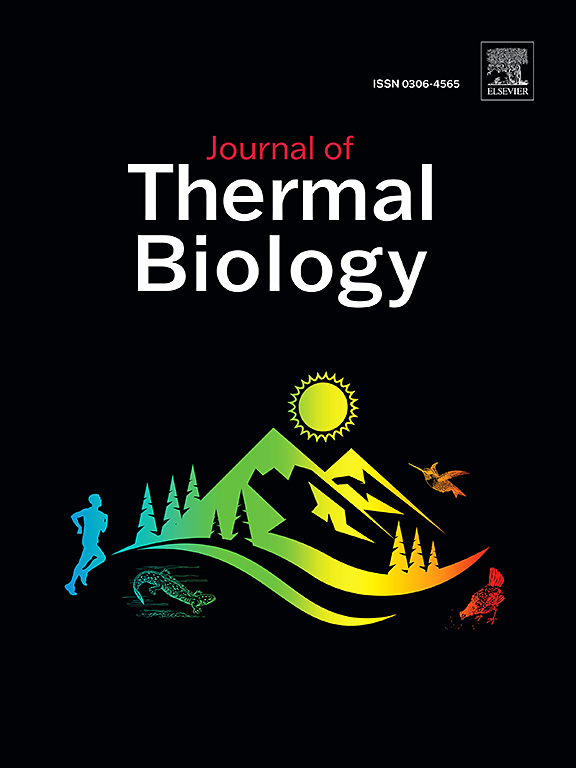红外热像仪测体温与毛羊生产性能、饲料效率和肠内气体排放的关系
IF 2.9
2区 生物学
Q2 BIOLOGY
引用次数: 0
摘要
红外热像仪(IRT)是一种非侵入性方法,是优化牲畜测量的主要间接工具之一,因为大多数生理条件的变化都会影响体温。本研究旨在评估利用IRT来估算毛羊的剩余采食量(RFI)和剩余采食量与增重(RIG),以及生产性能、饲料效率估算和气体排放的变化。在两次饲料效率试验中对40只羔羊进行监测,以评估生产性能、饲料效率估算和肠道气体排放。这些指标与来自不同身体区域(眼睛、蹄子、瘤胃和左侧)的IRT测量相关联。温度测量采用Fluke相机采集的红外图像,采用非稳态快速检测测量方法。羔羊分为高(RFI-;RIG+),中(RFI±;RIG±),低(RFI+;RIG-)分类基于调整后的RFI和RIG的±0.5个标准差。为了评估组间差异,Tukey’s test (P <;0.05),并采用Pearson相关和多变量分析来确定变量之间的关系。在第2个测试中,观察了眼睛和左侧体温的RIG分类差异。一些性能变量和饲料效率估计,如干物质采食量、饲料效率和饲料转化率,因RFI和RIG分类而异。在第1个测试中,不同RFI分类之间只有N2O和NH4排放量不同,而在第2个测试中,RFI +动物的CO2排放量更高。性能和饲料效率估计是主要变量,而IRT测量的温度对RFI和RIG类别具有最低的区分能力,其次是肠道气体排放。本研究受动物数量和环境温度变化的限制,有必要进一步研究红外热成像与动物生产效率之间的关系。本文章由计算机程序翻译,如有差异,请以英文原文为准。
Relationship between body temperature measured by infrared thermography and performance, feed efficiency and enteric gas emission of hair lambs
Infrared thermography (IRT) is a noninvasive method that is one of the main indirect tools to optimize livestock measurements, as most changes in physiological conditions affect body temperature. This study aimed to evaluate the use of IRT to estimate residual feed intake (RFI) and residual intake and gain (RIG) of hair lambs, in addition to variations in performance, feed efficiency estimates, and gas emissions. Forty lambs were monitored during two feed efficiency tests to assess performance, feed efficiency estimates, and enteric gas emissions. These metrics were associated with IRT measurements from different body regions (eyes, hooves, rumen, and left flank). Temperatures were measured using infrared images collected with a Fluke camera, employing the non-steady-state rapid detection measurement method. Lambs were grouped into high (RFI-; RIG+), medium (RFI±; RIG±), and low (RFI+; RIG-) classes based on ± 0.5 standard deviations of adjusted RFI and RIG. To assess group differences, Tukey's test (P < 0.05) was applied, along with Pearson correlation and multivariate analyses to determine relationships between variables. In the 2nd test, differences in RIG classification were observed for eye and left flank temperatures. Some performance variables and feed efficiency estimates, such as dry matter intake, feed efficiency, and feed conversion, differed by RFI and RIG classifications. In the 1st test, only N2O and NH4 emissions differed between RFI classifications, while in the 2nd test, CO2 emissions were higher in RFI + animals. Performance and feed efficiency estimates were the primary variables, whereas temperatures measured by IRT had the lowest discriminatory power for RFI and RIG categories, followed by enteric gas emissions. Limitations related to animal numbers and environmental temperature variation in this study suggest that further investigation of the relationship between infrared thermography and animal performance efficiency is warranted.
求助全文
通过发布文献求助,成功后即可免费获取论文全文。
去求助
来源期刊

Journal of thermal biology
生物-动物学
CiteScore
5.30
自引率
7.40%
发文量
196
审稿时长
14.5 weeks
期刊介绍:
The Journal of Thermal Biology publishes articles that advance our knowledge on the ways and mechanisms through which temperature affects man and animals. This includes studies of their responses to these effects and on the ecological consequences. Directly relevant to this theme are:
• The mechanisms of thermal limitation, heat and cold injury, and the resistance of organisms to extremes of temperature
• The mechanisms involved in acclimation, acclimatization and evolutionary adaptation to temperature
• Mechanisms underlying the patterns of hibernation, torpor, dormancy, aestivation and diapause
• Effects of temperature on reproduction and development, growth, ageing and life-span
• Studies on modelling heat transfer between organisms and their environment
• The contributions of temperature to effects of climate change on animal species and man
• Studies of conservation biology and physiology related to temperature
• Behavioural and physiological regulation of body temperature including its pathophysiology and fever
• Medical applications of hypo- and hyperthermia
Article types:
• Original articles
• Review articles
 求助内容:
求助内容: 应助结果提醒方式:
应助结果提醒方式:


